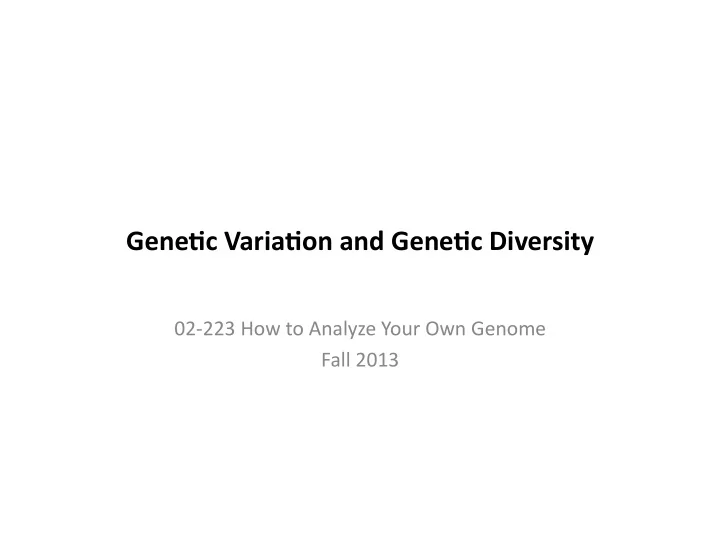

Gene$c ¡Varia$on ¡and ¡Gene$c ¡Diversity ¡ 02-‑223 ¡How ¡to ¡Analyze ¡Your ¡Own ¡Genome ¡ Fall ¡2013 ¡
Terminology ¡ Allele: ¡different ¡forms ¡of ¡gene@c ¡ • Individual ¡1 ¡ C ¡ varia@ons ¡at ¡a ¡given ¡gene ¡or ¡ gene@c ¡locus ¡ A ¡ G ¡ – Locus ¡1 ¡has ¡two ¡alleles, ¡A ¡and ¡T, ¡ and ¡Locus ¡2 ¡has ¡two ¡alleles, ¡C ¡and ¡ Locus ¡2 ¡ G ¡ A ¡ Locus ¡1 ¡ Genotype: ¡specific ¡allelic ¡make-‑up ¡ • of ¡an ¡individual’s ¡genome ¡ C ¡ Individual ¡2 ¡ – Individual ¡1 ¡has ¡genotype ¡AA ¡at ¡ Locus ¡1 ¡and ¡genotype ¡CG ¡at ¡Locus ¡ A ¡ C ¡ 2 ¡ Locus ¡2 ¡ T ¡ Heterozygous/Homozygous ¡ • – Locus ¡1 ¡of ¡Individual ¡1 ¡is ¡ Locus ¡1 ¡ homozygous, ¡and ¡Locus ¡2 ¡is ¡ heterozygous ¡
Single ¡Nucleo$de ¡Polymorphisms ¡(SNPs) ¡ ¡ ¡
Advantages ¡of ¡SNPs ¡in ¡Popula$on ¡Gene$cs ¡ Studies ¡ Abundance: ¡high ¡frequency ¡on ¡the ¡genome ¡ • Posi@on: ¡throughout ¡the ¡genome ¡ ¡ • – coding ¡region, ¡intron ¡region, ¡promoter ¡site ¡ Ease ¡of ¡genotyping ¡(high-‑throughput ¡genotyping) ¡ • Less ¡mutable ¡than ¡other ¡forms ¡of ¡polymorphisms ¡ • SNPs ¡account ¡for ¡around ¡90% ¡of ¡human ¡genomic ¡varia@on ¡ • • About ¡10 ¡million ¡SNPs ¡exist ¡in ¡human ¡popula@ons ¡ Most ¡SNPs ¡are ¡outside ¡of ¡the ¡protein ¡coding ¡regions ¡ • 1 ¡SNP ¡every ¡600 ¡base ¡pairs ¡ • More ¡than ¡5 ¡million ¡common ¡SNPs ¡each ¡with ¡frequency ¡10-‑50% ¡account ¡for ¡the ¡bulk ¡of ¡ • human ¡DNA ¡sequence ¡difference ¡ • It ¡is ¡es@mated ¡that ¡~60,000 ¡SNPs ¡occur ¡within ¡exons; ¡85% ¡of ¡exons ¡are ¡within ¡5 ¡kb ¡of ¡the ¡ nearest ¡SNP ¡ • Account for most of the genetic diversity among different (normal) individual, e.g. drug response, disease susceptibility � • However, ¡only ¡two ¡alleles ¡at ¡each ¡locus, ¡less ¡informa@ve ¡than ¡microsatellites. ¡(Use ¡ haplotypes!) ¡
Working ¡with ¡SNP ¡Data ¡in ¡Prac$ce ¡ • At ¡each ¡locus, ¡SNPs ¡are ¡represented ¡as ¡0 ¡or ¡1. ¡ – A/T/C/G ¡lecers ¡are ¡converted ¡to ¡0 ¡or ¡1 ¡for ¡minor/major ¡alleles ¡ – Genotypes ¡at ¡each ¡locus ¡of ¡each ¡individual ¡are ¡coded ¡as ¡ • 0 ¡: ¡minor ¡allele ¡homozygous ¡ • 1: ¡heterozygous ¡ • 2: ¡major ¡allele ¡homozygous ¡ • Given ¡genotype ¡data ¡for ¡ N ¡individuals ¡ • For ¡each ¡locus, ¡we ¡can ¡define ¡minor ¡allele ¡frequency ¡as ¡follows: ¡ ¡(Minor ¡allele ¡frequency) ¡= ¡(the ¡number ¡of ¡minor ¡alleles ¡in ¡the ¡ popula@on)/(total ¡number ¡of ¡alleles ¡in ¡the ¡popula@on) ¡ • Typically, ¡SNPs ¡with ¡a ¡very ¡low ¡minor ¡allele ¡frequency ¡are ¡discarded, ¡ since ¡they ¡don’t ¡contain ¡sufficient ¡informa@on ¡about ¡gene@c ¡diversity ¡
The ¡Effects ¡of ¡Single ¡Nucleo$de ¡Muta$ons ¡ Muta@ons ¡in ¡the ¡protein ¡coding ¡regions ¡ • – Nonsynonymous ¡muta@ons ¡ • Missense ¡muta@ons ¡change ¡the ¡protein ¡sequence ¡ – CAC ¡in ¡RNA ¡(or ¡DNA) ¡codes ¡for ¡amino ¡acid ¡ his , ¡but ¡if ¡A ¡is ¡mutated ¡to ¡U ¡(CUC), ¡it ¡ codes ¡for ¡amino ¡acid ¡ leu ¡ • Nonsense ¡muta@ons ¡truncate ¡the ¡protein ¡ – UGG ¡codes ¡for ¡amino ¡acid ¡trp, ¡but ¡if ¡G ¡is ¡mutated ¡to ¡A ¡(UAG), ¡it ¡becomes ¡a ¡stop ¡ codon. ¡ – Synonymous ¡muta@ons ¡do ¡not ¡change ¡amino ¡acids ¡ • Both ¡CAC ¡and ¡CAU ¡result ¡in ¡amio ¡acid ¡ his ¡ • However, ¡such ¡muta@ons ¡could ¡affect ¡splice ¡sites ¡ Muta@ons ¡in ¡the ¡regulatory ¡(non-‑coding) ¡regions ¡ • – We ¡have ¡very ¡licle ¡understanding ¡of ¡the ¡regulatory ¡regions ¡and ¡muta@ons ¡in ¡them ¡
Gene$c ¡Polymorphisms ¡ • Inser@on/dele@on ¡of ¡a ¡sec@on ¡of ¡DNA ¡ – Minisatellites: ¡repeated ¡base ¡pacerns ¡(several ¡hundred ¡base ¡pairs) ¡ – Microsatellites: ¡2-‑4 ¡nucleo@des ¡repeated ¡ – Presence ¡or ¡absence ¡of ¡Alu ¡segments ¡ – Many ¡alleles, ¡very ¡informa@ve ¡because ¡of ¡the ¡high ¡heterozygosity ¡(the ¡ chance ¡that ¡a ¡randomly ¡selected ¡person ¡will ¡be ¡heterozygous) ¡
Gene$c ¡Polymorphisms ¡ • Structural ¡variants ¡ ¡ – inser@ons/dele@ons, ¡duplica@ons, ¡copy ¡number ¡varia@ons ¡
Gene$c ¡Polymorphisms ¡ • Copy ¡Number ¡Varia@on ¡ – DNA ¡segment ¡whose ¡numbers ¡differ ¡in ¡different ¡genomes ¡ • Kilobases ¡to ¡megabases ¡in ¡size ¡ – Usually ¡two ¡copies ¡of ¡all ¡ ¡autosomal ¡regions, ¡one ¡per ¡chromosome ¡ – Varia@on ¡due ¡to ¡dele@on ¡or ¡duplica@on ¡
Gene$c ¡Polymorphisms ¡ • Copy ¡Number ¡Varia@ons ¡+ ¡SNPs ¡
Detec$ng ¡Gene$c ¡Polymorphisms ¡from ¡ Shotgun ¡Sequencing ¡
Gene$c ¡Variant ¡Frequencies ¡from ¡1000 ¡ Genome ¡Pilot ¡Project ¡ Frequency ¡of ¡SNPs ¡greater ¡than ¡that ¡of ¡any ¡other ¡type ¡of ¡polymorphism ¡
Gene$c ¡Markers ¡ • Gene@c ¡markers ¡ – DNA ¡sequence ¡with ¡a ¡known ¡physical ¡loca@on ¡on ¡a ¡chromosome ¡ – An ¡iden@fiable ¡segment ¡of ¡DNA ¡(e.g., ¡SNPs, ¡microsatellites) ¡with ¡ enough ¡varia@on ¡between ¡individuals ¡that ¡its ¡inheritance ¡and ¡co-‑ inheritance ¡with ¡alleles ¡of ¡a ¡given ¡gene ¡can ¡be ¡traced ¡ – Gene@c ¡markers ¡can ¡be ¡used ¡to ¡refer ¡to ¡a ¡par@cular ¡loca@on ¡in ¡ genomes ¡or ¡in ¡a ¡gene@c ¡map. ¡ hcp://www.genome.gov/glossary/index.cfm?id=86 ¡ Check ¡out ¡the ¡“Listen” ¡voice ¡recording ¡of ¡Dr. ¡Hurle’s ¡ explana@on ¡of ¡gene@c ¡markers ¡
Summry ¡ • Alleles ¡and ¡genotypes ¡ • Different ¡types ¡of ¡gene@c ¡polymorphisms ¡ – Single ¡nucleo@de ¡polymorphisms ¡(SNPs) ¡ – Structural ¡variants ¡ • Inser@ons, ¡dele@ons, ¡copy ¡number ¡varia@ons ¡etc. ¡ – SNPs ¡are ¡the ¡most ¡abundant ¡polymorphisms ¡and ¡are ¡oqen ¡used ¡as ¡ gene@c ¡markers ¡
Recommend
More recommend